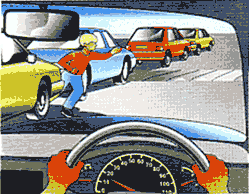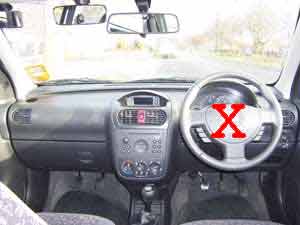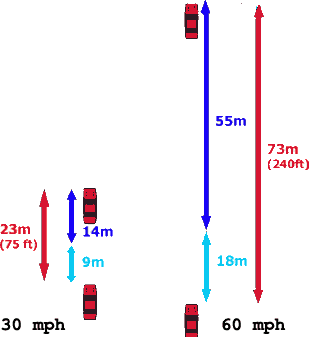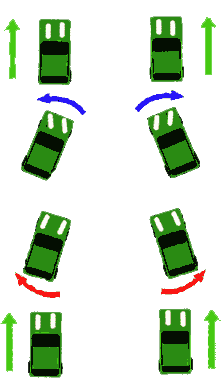 The Emergency Stop
The Emergency Stop Introduction
A good driver will alway be driving defensively and anticipating the unexpected. By looking well ahead, being aware of the situation behind and to the sides, being prepared for the unexpected and always driving at a speed that will enable you to stop within the distance you can see to be clear (AND SLOWING DOWN IF IT'S NOT) you can generally avoid finding yourself in an emergency situation.
looking well ahead, being aware of the situation behind and to the sides, being prepared for the unexpected and always driving at a speed that will enable you to stop within the distance you can see to be clear (AND SLOWING DOWN IF IT'S NOT) you can generally avoid finding yourself in an emergency situation.
But we do need to be able to react and be able to stop for a situation such as a child suddenly stepping out into the road - if we did encounter this we would have to be able to stop promptly and under control.
The child running unexpectedly into the road is an obvious example - but which of these situations would require the driver to perform an emergency stop
click on an image for the answer
Neither of these situations should result in you having to brake for an emergency.
Where there is an ice cream van parked at the side of the road a good driver will anticipate children being around and be prepared for one emerging quickly from behind the van - he would have checked his mirrors - adjusted his speed if necessary and anticipated the fact that a child may come out suddenly from behind the van.
Whenever you are driving along a road with parked vehicles at the side particularly when they are large and severely obstructing your view, you should be ready for the unexpected to happen - it is a common occurrence for pedestrians to cross the road between parked vehicles - if you are ready to react to this it is unlikely that this will develop into an emergency because the adult is likely to be walking rather than running like the child chasing a ball.
A well prepared driver will have adjusted his speed and allowed himself plenty of time to react.
Lesson Outline
We won't drive around looking for an emergency situation during the lesson!
We'll have to drive to a safe place and I will be checking to make sure it's absolutely safe before asking you to practise the manoeuvre.
Many learner drivers find the thought of performing an emergency stop a little intimidating - don't worry I'll brief you fully before we start and we'll begin to practise at very slow speeds until you are confident with the technique when we'll build up the speed gradually.
By the end of the lesson you'll enjoy the feeling of knowing that if did encounter an emergency you could stop quickly and safely if it were necessary.
How to Brake
Quick Reactions 
In an emergency the priority is to stop the vehicle as quickly as possible, the sooner you can start braking the sooner the vehicle can be brought to a stop.
Mirrors
This is the only occasion that you will not use your mirrors before a manoeuvre. The vehicle could travel about 25ft in the half second it could take to check your mirrors - in an emergency this could be the difference between avoiding an accident and being involved in a collision.
Firm & Progressive Braking
When you put your foot on the brake pedal, you should brake firmly and progressively and keep pressing the brake as the car slows down (but avoid applying so much pressure that the wheels lock. Obviously the intention is to stop quickly but if you lock the wheels the car could skid meaning we would have less control and it may take longer to stop.
Clutch
Just before you stop push the clutch down, leaving the clutch to the very end allows the engine to assist with the braking. Pushing the clutch down too soon will disengage the engine from the drive wheels and the car will lose the engine braking effect.
Steering 
Keep both hands on the wheel to give the best possible control and assist you in keeping the wheels straight. - as this could induce a skid - keep both hands on the wheel until the car has fully stopped.
When Stopped
Once you have come to a halt apply the handbrake and select neutral.
Check All Round
Having stopped in an emergency your car will be well out into the road. Before moving off you must check all round and over both shoulders to make sure it is safe to move off.

Hazards
It is important to remember that the road surface and weather conditions can dramatically affect the efficiency of braking.
In wet weather it can take up to twice the distance to bring your vehicle to a stop.

In icy weather conditions the distance can be increased by up to ten times!
So when we're driving in hazardous conditions it is important that we only drive at a speed suitable for the conditions - we must be able to stop within the distance that we can see to be safe!
This diagram illustrates the effect that speed has on stopping distances under normal driving conditions - at 30mph the overall stopping distance is 23m which is made up of 9m thinking distance and 14m braking distance.
At 60mph the thinking distance (18m)is twice the thinking distance at 30mph - but the braking distance is more than 5 times greater!
We must always be very careful about our speed when driving in difficult or hazardous conditions - if in doubt slow down.

If the rear of the car was breaking away to the left then you would turn or steer to the left - in other words "turn into the skid". This will help to straighten the car and if you have reduced the braking and the wheels have begun to roll then you will regain your control of the car.
And if the rear wheels broke to the right we'd steer right and reduce the braking pressure - once the car straightened we would have regained control and could apply gentle pressure on the gas to continue our journey.


Skids
Skids are caused by harsh braking, acceleration or steering.
There is a much greater danger of the car skidding in poor driving conditions and if the car should begin to skid we need to know how to regain control.
When we learn how to do the emergency stop in the car we'll be creating one of the situations that might cause a skid - we'll be braking harshly - earlier in the tutorial I said that we want to brake firmly and progressively but not so firmly that the wheels lock.
The maximum amount of braking force is achieved just before the point that the wheels lock - exactly how much force has to be applied to the brakes to achieve this is down to judgment and experience.
It is natural to be nervous of the car beginning to skid - and rightly so - if a skid occurs because we have used the controls harshly when driving too quickly for the weather or road conditions it can be difficult to control and can certainly be unnerving.
Don't be frightened of the thought of the car skidding when we learn the emergency stop in the car - remember we'll be doing it at slow speeds at first until you are confident and I'll be making sure that we are in a safe place before asking you to do it.
If we should feel the wheels begin to lock it's easy to deal with - here's how:
Because we'll be moving in a straight line and the skid will have been caused by harsh braking we'll continue to move in the same direction.
The rule for correcting a skid is simple: REMOVE THE CAUSE OF THE SKID
So in this case all we would have to do is take our foot off the brake pedal very briefly - once the tyres had regained their grip the wheels will begin to turn again and the brakes can be re-applied again if necessary - that's all there is to it.
In many situations however the combinations of conditions and harsh use of the controls can result in the rear of the car breaking away causing the car to skid about it's own axis. I'll explain how to deal with this with the aid of this diagram.
If the rear of the car was breaking away to the left then you would turn or steer to the left - in other words "turn into the skid". This will help to straighten the car and if you have reduced the braking and the wheels have begun to roll then you will regain your control of the car.

Summary
It is important that you understand how to react in an emergency. When we've learnt and practised the manoeuvre in the car your confidence will develop once you realise how quickly and easily you can stop the car if you need to - you will also learn more about the amount of braking pressure required to stop the car in situations other than emergency but the car has to be stopped or slowed down quickly.
Remember the most important message in this tutorial is how to avoid the need for emergency braking - even at this early stage of your training you should always be alert, looking well ahead and prepared to react early to unexpected events.
You have been shown the 2 most common types of skid and been introduced to how to deal with them in this tutorial - there are other types of skid and you should read about them and how to deal with them in "Driving - the essential skills"
You should also read The Highway Code pages 97 - 105 which explains about vehicle control and includes information about stopping distances.
By the time we have done lots of practice you will be able to perform an emergency stop at about 30 mph - you will then be able to relate this to the shortest stopping distance that can be achieved in a well maintained car, in good weather and on a sound road surface (23 metres or 75ft or 6 car lengths) - this should help you judge the distances for other speeds by having a mental picture of how much distance you need to stop at 30mph.
A final note:
The techniques I have introduced you to in this tutorial are for cars with traditional braking systems (like the car you will be learning in). Many new cars have anti lock braking systems (ABS) if you should be driving a car with ABS in the future you should refer to the vehicle manual for advice on how to use it effectively.
If you would like a quick introduction on how ABS works then ask me during one of our lessons and I'll explain briefly how they work.

